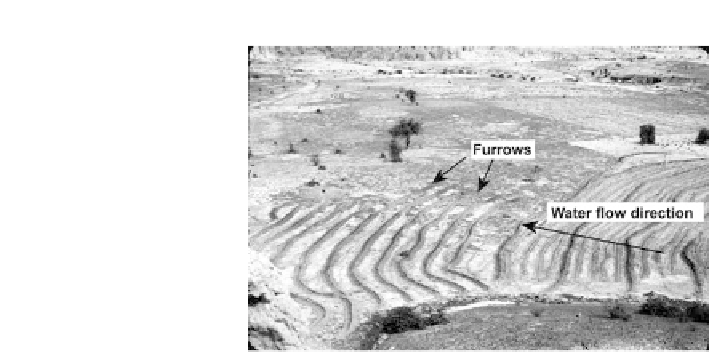Agriculture Reference
In-Depth Information
Figure
8.15.
Experimental plot in Niger. Arrow shows direction of water flow and furrows
designed to stop the flow.
water during all months of the year. This means that as long as there is no other limiting
factor such as photoperiod sensitivity of the crop or insect or microbial infection, crops
can be planted and grown at any time during the year. This is the case with rice. In the
area between Baybay and Ormoc, near the Philippine farm of Donio, on the island of
Leyte one observes rice paddies in all stages of growth and production at all times of
the year.
In some areas rainfall occurs in the nongrowing season and water stored in the soil
is used during the growing season. In these cases it is often beneficial to supplement
soil-stored water with irrigation. In the wheat-growing midwestern part of the United
States precipitation falls as snow during the winter. While winter wheat may be
planted and seen in the fields, it is, for the most part, not actively growing. Active
and productive growth occurs in the late spring and often depends on soil-stored
water. In many places rivers fed by melting snow in the surrounding mountains are
used for irrigation in these areas.
In those areas where there is insufficient rain for rainfed crop production, extensive
irrigation will be practiced if there is a sufficient source of water. This may be a stream
or river, which originates in mountains, where there is higher rain or snowfall that melts
to provide water for the rivers. In some cases this may be done on a small scale and be
called water or rain harvesting.
Another source of water for irrigation is wells. Here water is pumped out of the
ground and used to irrigate crops. In this case extreme caution must be exercised.
First, the recharge, water coming into the aquifer being used, must be high enough
to replace all the water used for irrigation in a year. If this is not the case, irrigation
will not be sustainable, and the water will be depleted and future irrigation will fail.
Second, wells may be dug or drilled into water sources that are contaminated. This
has happened in California with selenium and in Bangladesh with arsenic. Third, the
water may be salty such as to preclude its use as irrigation water. Thus, extensive
testing, both geological and chemical, of waters to be used in irrigation must
be undertaken.








